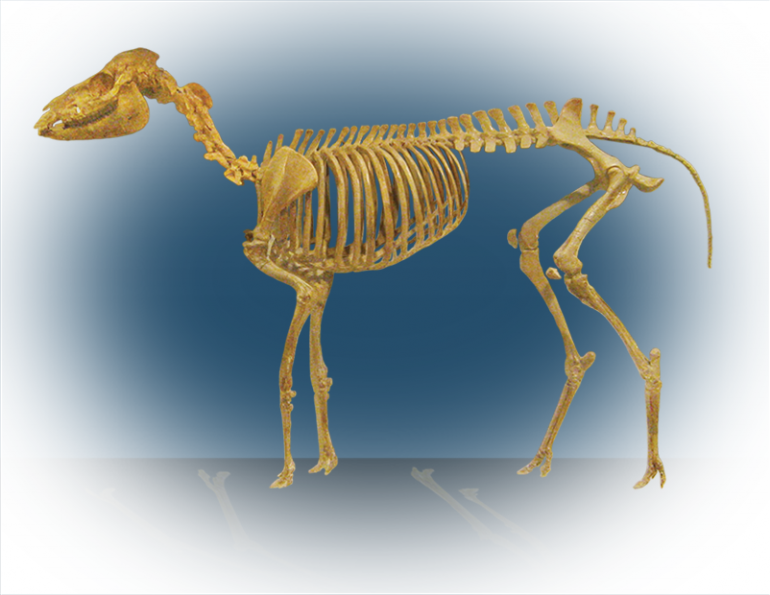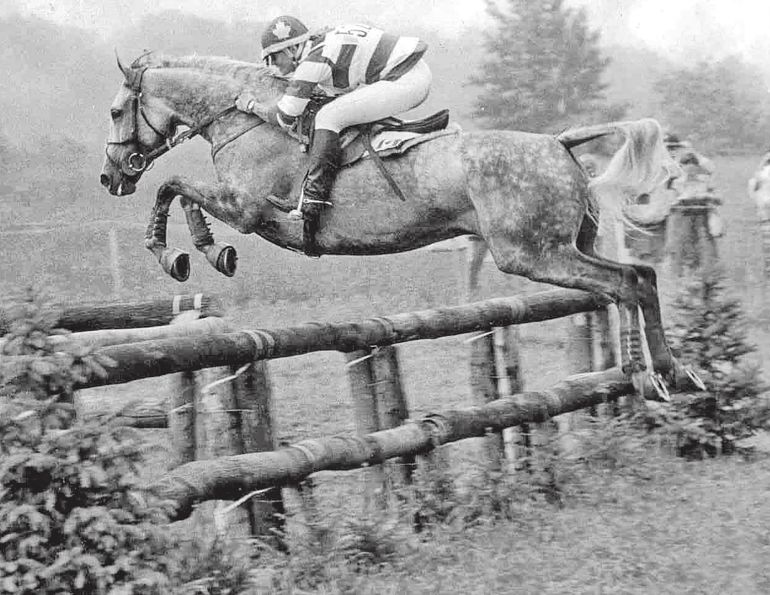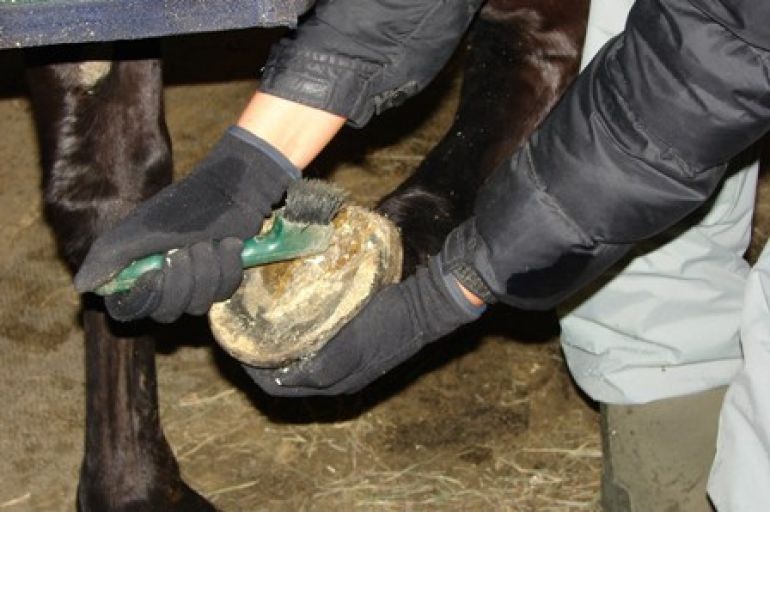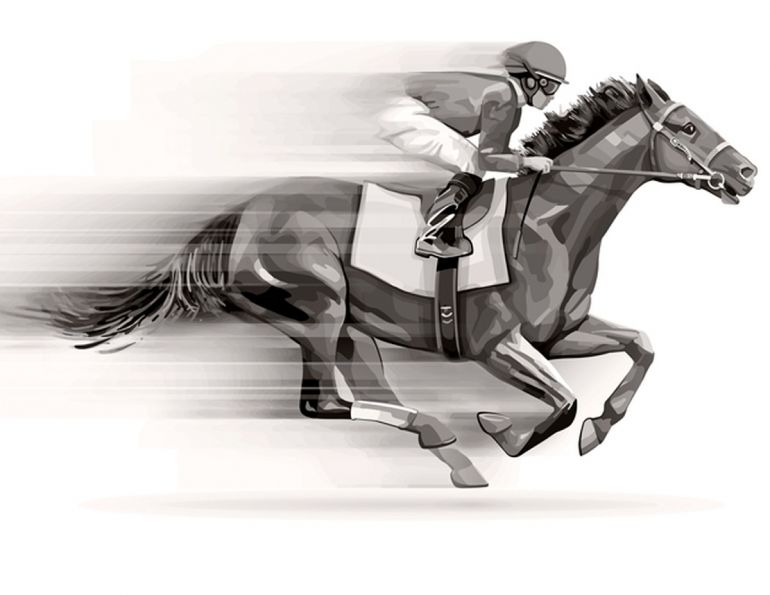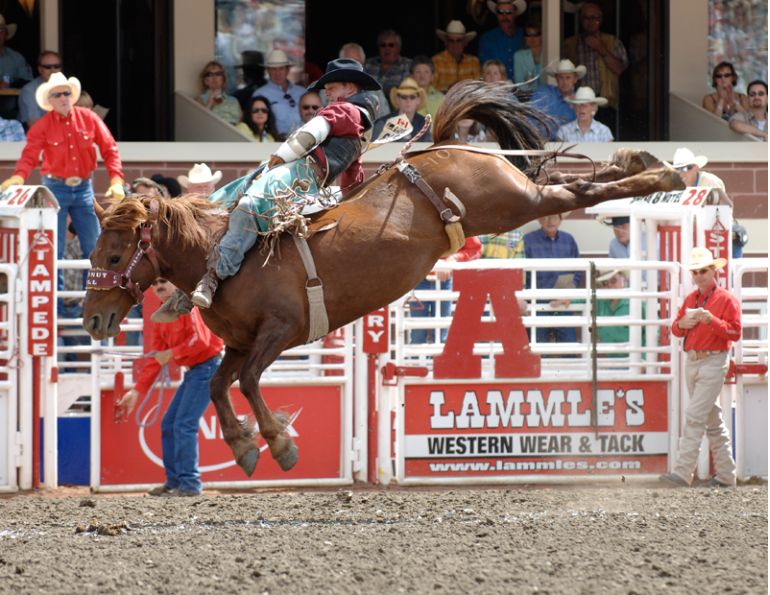By Margaret Evans
Do horses have just one toe – the complex hoof – or do they, in fact, still have remnants of all of their original five toes with four of them hidden from view?
Horses evolved some 55 million years ago in North America as small, dog-size mammals with five toes. The climate was warm, wet, and subtropical, and having toes that spread out to pad around the forest floor was ideal. But as the climate changed, so did the little horses.
Over an immense amount of time the horses adapted to cooling climates and changing landscapes that replaced forest with grassland. They became flight animals, which required them to grow bigger and run faster. Their cardiovascular system expanded and their limbs lengthened to end in a single hardened hoof capsule capable of supporting the greater weight and speed. It was assumed in scientific circles that the redundant side toes shrank and eventually disappeared. But did those ancient toes, or digits, disappear altogether?
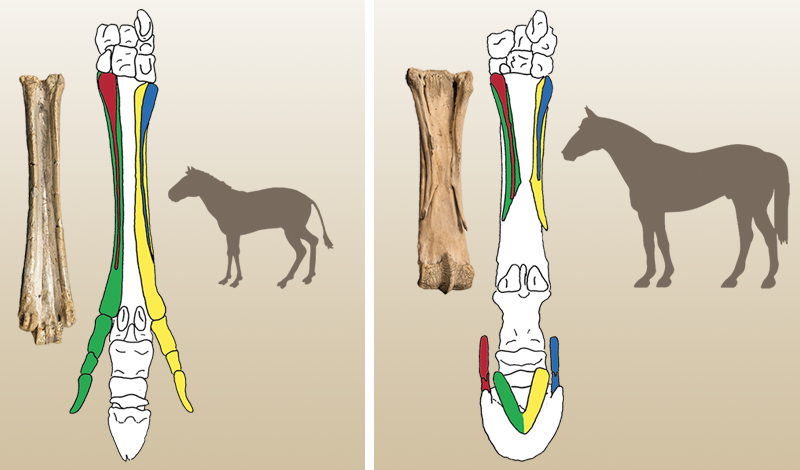
Silhouettes show Mesohippus primigenium, an early ancestor of the modern horse that lived some 38 million years ago and was previously believed to have three toes, and the modern horse. Photographs of both animals’ hand bones appear alongside renderings of the researchers’ proposed digit identities.
The researchers argue that missing digits one and five are partially expressed on the surfaces of the side toes (shown in red/blue). While the horse is described as being monodactyl, with only one complete digit, the researchers demonstrate that digits two and four are expressed as the splint bones and frog (padding of the foot), as shown in yellow/green. Missing digits one and five are expressed as ridges on the splint bones and as the hoof cartilages, as shown in the lower red/blue areas. Photos and caption courtesy New York Institute of Technology
As of 2019, researchers at the New York Institute of Technology, College of Osteopathic Medicine (NYITCOM) suggest that, in fact, the four side toes did not completely disappear but remain even today as remnants still present within the horse’s modern lower leg and hoof.
Scientists widely accept that the essentially redundant splint bones – the small bones found along the outer sides of the metacarpal or cannon bone - are remnants of the second and fourth toes. The upper two-thirds of the bones are connected to the cannon bone by dense ligament, while the lower parts of the bones flare slightly but remain connected and stabilized by soft tissue. But according to the NYITCOM researchers, there’s a bigger picture that traces the remnants of digits one and five. Rather than being lost to evolution, these digits appear to be found along the ridges of the splint bones, demonstrating that they have possibly fused with digits two and four.
“It’s not surprising,” says Nikos Solounias, paleontologist and anatomy professor with the College of Osteopathic Medicine. “Overall, evolution is creative and yet very conservative, so the other digits remain but are not fully expressed. In many new structures you can see how the old anatomy is not lost but preserved in some way. The new structures are built upon the old by using new combinations. It’s rare to find a structure that is totally new material.”
For many years Solounias thought that the dominant digit three – the hoof – included within it the other digits. But persistence and hard work revealed a simple theory. He explains that the splint bones contain their own elevated surfaces that hold the evolutionary clues.
“I think the splint bones are doubled two digits per splint bone. Others thought it was one. My evidence is that in Anchitherium and Mesohippus the ridges on the splints are detachable, proving the double nature of each. In the horse they too are detachable. We find these ridges, located on the posterior of each splint, to be partially formed remains of the first and fifth digits which were once connected to the cartilages of the hoof.”
Anchitherium was a three-toed horse that lived some 20 million years ago and migrated to Asia, then spread to Europe and Africa. Mesohippus lived 38 to 32 million years ago and also had just three toes. Mesohippus is often known as the “middle horse,” being the link between the early small horses – the original tiny five-toed horses of the Eocene – and horses in transition to becoming the more familiar equine. The modern Equus first appeared about four million years ago.

Nikos Solounias, paleontologist and anatomy professor with the College of Osteopatic Medicine, with co-investigator Melinda Danowitz. Photo courtesy of New York Institute of Technology.
Solounias first considered his theory almost 20 years ago when studying fossil evidence from Hipparion horses. The Hipparion genus appeared during the Miocene epoch about 12 million years ago and survived to about 3 million years ago. They originated in North America and some populations migrated to Asia, Europe, and Africa. The famous Laetoli footprints in Tanzania embedded in fossilized volcanic ash from 3.5 million years ago show not only the first discovery of bipedal hominin footprints, but the imprints of three three-toed Hipparion horses moving at a running walk across the same volcanic field. The crisscrossing pattern suggests the travel was of two adult horses and a foal.
On studying those fossilized imprints, Solounias noticed that the bottom surface of the horse’s fossilized forelimb appeared to be divided in five sections as though small toes had bonded together. Further study of the impressions convinced him that the horse not only had five compacted toes, but had passed the trait along to the next generation of Hipparion horses in the imprints of the foal.
“Interestingly, we find not only hints of the missing digits on the modern horse, but also on its ancestors such as Hipparion and Mesohippus, two species believed to have three toes,” he says, adding that there needs to be closer examination and deeper studies in the reconstruction of extinct horse species.
In many ways, the changes seen in extinct horse species are in fact their adaptations to climate change and the profound influences of the changes within their landscape from forest to grassland.
“The single hoof (compressing [five] toes into one) enables the horse to move well on tough terrain,” says Solounias. “Its dentition is also well adapted to feeding on grasses and rough food. Both of these enable these animals to live in dry grassy areas.”
Melinda Danowitz, Solounias’ co-investigator in the study and a recent NYITCOM graduate, says that while the horse’s lineage is usually described as having evolved from four toes to three to a single toe, its ancestors exhibit the reduced toes at both the wrist and the hoof.
“These findings show that today’s horse is not truly monodactyl [one-toed] and earlier ancestors were not in fact tridactyl or tetradactyl, that is, three-toed or four-toed,” she says.
In support of the five-digit remnant theory, the researchers discovered neurovascular evidence. Dissections of the forelimbs of a modern equine fetus revealed a greater number of arteries and nerves than would be expected in a single digit.
Solounias says that the horse embryo they examined was only 20 millimetres long. “It has a foot like the adult. In other words, the other digits do not appear and reabsorb. They appear partially formed as in the adult.”
Danowitz says that if today’s horse does only have one digit per forelimb, then each limb would only have two veins, two arteries, and two nerve bundles. “However, our dissections found between five and seven neurovascular bundles per forelimb, suggesting that additional toes begin to develop, but do not become fully differentiated.”
Clearly, understanding horse evolution remains a fascinating work in progress. Adaptation was the hallmark of the horse’s evolutionary success. As they grew bigger, heavier, and faster, and gained abilities to run at high speed, jump obstacles, dodge predators, and rapidly react to the onset of danger, their feet took on a critical load-bearing role. They tucked away the toes they no longer needed and ran with the new improved model.
The research study was published in the journal Royal Society Open Science.
Main photo: Picture of a reconstructed fossil of Mesohippus at the Harvard Museum of Natural History. This one lived in South Dakota, USA, more than 30 million years ago. Photo: Wikimedia/David Starner



